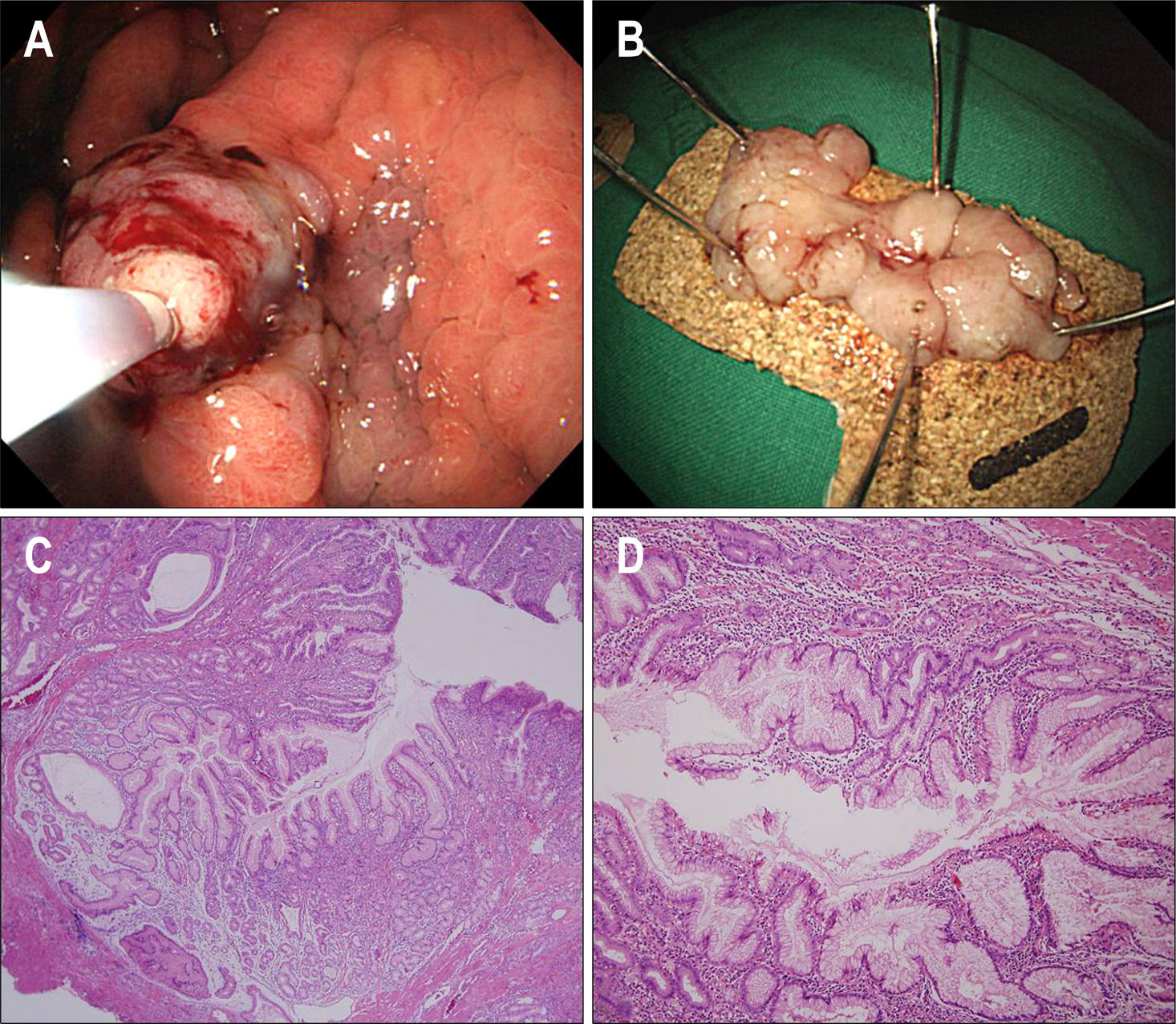Korean J Gastroenterol.
2011 Mar;57(3):184-188. 10.4166/kjg.2011.57.3.184.
A Case of Menetrier's Disease Showing Mucus Bridge Observed during Endoscopy
- Affiliations
-
- 1Department of Internal Medicine, Pusan National University School of Medicine, Busan, Korea. doc0224@pusan.ac.kr
- 2Department of Pathology, Pusan National University School of Medicine, Busan, Korea.
- KMID: 1128358
- DOI: http://doi.org/10.4166/kjg.2011.57.3.184
Abstract
- Menetrier's disease is a rare entity characterized by large, tortuous gastric mucosal folds. The mucosal folds in Menetrier's disease are often most prominent in the body and fundus. Histologically, massive foveolar hyperplasia (hyperplasia of surface and glandular mucous cells) is noted, which replaces most of the chief and parietal cells. Profuse mucus is usually observed during the endoscopy but there have been few cases that show interesting endoscopic findings such as mucus bridge or water pearl. Herein, we report a case of Menetrier's disease showing mucus bridge by excessive mucus observed during the endoscopy.
Keyword
MeSH Terms
-
2-Pyridinylmethylsulfinylbenzimidazoles/therapeutic use
Amoxicillin/therapeutic use
Anti-Bacterial Agents/therapeutic use
Clarithromycin/therapeutic use
Drug Therapy, Combination
Gastric Mucosa/*pathology/secretion
Gastritis, Hypertrophic/*diagnosis/pathology
Gastroscopy
Helicobacter Infections/diagnosis/drug therapy
Helicobacter pylori
Humans
Male
Middle Aged
Mucus/secretion
Proton Pump Inhibitors/therapeutic use
Tomography, X-Ray Computed
Figure
Reference
-
References
1. Menetrier P. Des polyadenomes gastriques et de leurs rapports avec le cancer de I'estomac. Arch Physiol Norm Pathol. 1888; 32:236–262.2. Valle John D. Peptic Ulcer Disease and Related Disorders. Fauci AS, Braunwald E, Kasper DL, Hauser SL, Longo DL, Jameson JL, Loscalzo J, editors. Harrison's principles of internal medicine. Vol 2. 17th ed.New York: McGraw Hill;2008. p. 1871–1872.3. Romano M, Polk WH, Awad JA, et al. Transforming growth factor alpha protection against drug-induced injury to the rat gastric mucosa in vivo. J Clin Invest. 1992; 90:2409–2421.
Article4. Dempsey PJ, Goldenring JR, Soroka CJ, et al. Possible role of transforming growth factor alpha in the pathogenesis of Ménétrier's disease: supportive evidence form humans and transgenic mice. Gastroenterology. 1992; 103:1950–1963.5. Takagi H, Jhappan C, Sharp R, Merlino G. Hypertrophic gastropathy resembling Ménétrier's disease in transgenic mice overexpressing transforming growth factor alpha in the stomach. J Clin Invest. 1992; 90:1161–1167.
Article6. Megged O, Schlesinger Y. Cytomegalovirus-associated protein-losing gastropathy in childhood. Eur J Pediatr. 2008; 167:1217–1220.
Article7. Lim YJ, Rhee PL, Kim YH, et al. Clinical features of Menetrier's disease in Korea. Korean J Gastrointest Endosc. 2000; 21:909–916.8. Ginès A, Pellise M, Fernández-Esparrach G, et al. Endoscopic ultrasonography in patients with large gastric folds at endoscopy and biopsies negative for malignancy: predictors of malignant disease and clinical impact. Am J Gastroenterol. 2006; 101:64–69.9. Songür Y, Okai T, Watanabe H, Motoo Y, Sawabu N. Endosonographic evaluation giant gastric folds. Gastrointest Endosc. 1995; 41:468–474.10. Scott HW Jr, Shull HJ, Law DH 4th, Burko H, Page DL. Surgical management of Menetrier's disease with protein-losing gastropathy. Ann Surg. 1975; 181:765–777.
Article11. Jun DW, Kim DH, Kim SH, et al. Ménétrier's disease associated with herpes infection: response to treatment with acyclovir. Gastrointest Endosc. 2007; 65:1092–1095.
Article12. Jung JH, Hong SJ, Lee MS. Resolution of Menetrier's disease after Helicobacter pylori eradication. Korean J Gastroenterol. 2006; 48:1–3.13. Lim HJ, Park SJ, Seo JA, Moon W, Kim KJ, Park MI. A case of rapidly improved Menetrier's disease after short-term treatment with proton pump inhibitor. Korean J Gastrointest Endosc. 2008; 36:83–86.14. Rothenberg M, Pai R, Stuart K. Successful use of octreotide to treat Ménétrier's disease: a rare cause of abdominal pain, weight loss, edema, and hypoalbuminemia. Dig Dis Sci. 2009; 54:1403–1407.
Article15. Burdick JS, Chung E, Tanner G, et al. Treatment of Ménétrier's disease with a monoclonal antibody against the epidermal growth factor receptor. N Engl J Med. 2000; 343:1697–1701.
Article





